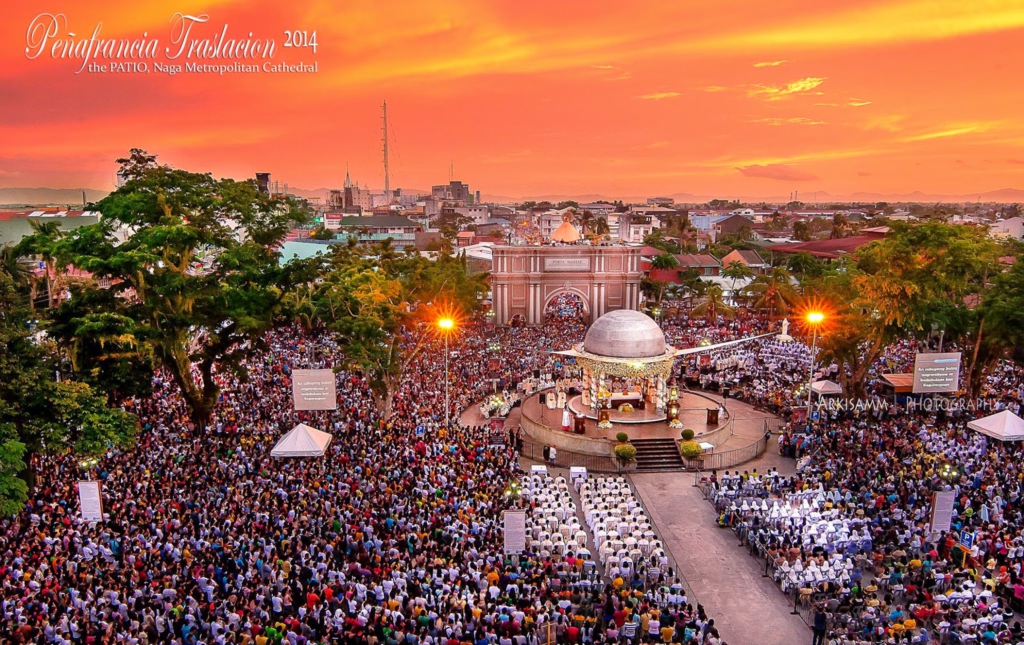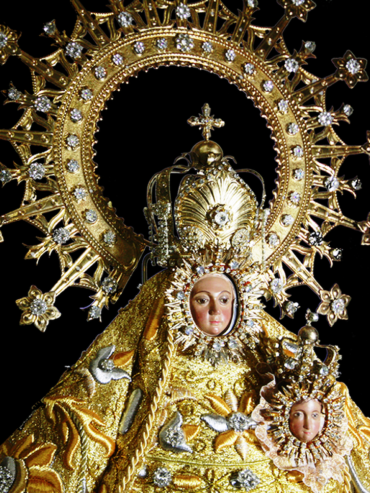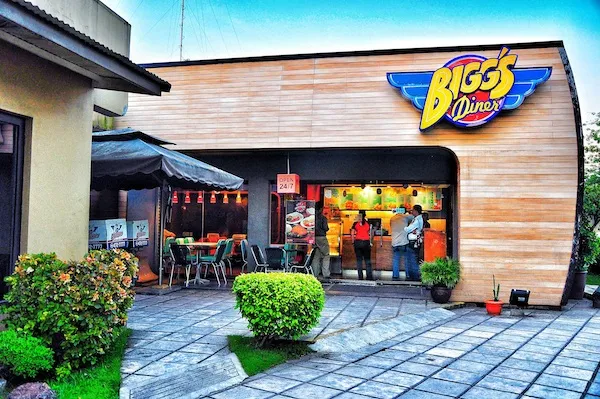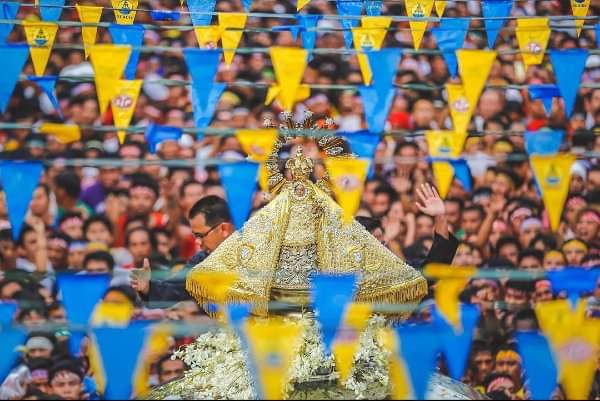Table of Contents

WHAT IS PEÑAFRANCIA FESTIVAL?
The Peñafrancia Festival is a celebration of two feasts—Divino Rostro (Divine Face of Jesus) and the Our Lady of Peñafrancia. The original schedule of the festival was every July but later on, changed to every Sunday in 1905 by Pope Pius X. This festival which is held in Naga City, Camarines Sur every September, has been called the largest and most popular Marian event in Asia. It is an annual cultural and religious celebration and is held as a month-long festivity. The first important part of the Peñafrancia Festival is the feast of the Divino Rostro. Divino Rostro is a local icon of the Holy Face and is honored through Novena.
The devotion to Divino Rostro is also expressed through the Peñafrancia festival. This devotion began in 1882 during the cholera epidemic. Fr. Pedro De La Torre placed the image of the Divino Rostro in the cathedral for people to pray for their safety and to be able to see it. When the Bishop of Nueva Caceres, Casimiro Herrera, had the image of Our Lady of Peñafrancia taken to the cathedral, it was the first time that the two images had been together. That was the beginning of one of the traditions of the Peñafrancia festival, the Traslacion.
Thousands of people visit Naga City, Camarines Sur every year to celebrate the festivities in honor of Our Lady of Peñafrancia. The Our Lady of Peñafrancia is the patroness of the Bicol Region. It was declared by Pope Leo XIII in 1895. The image of Our Lady of Peñafrancia is a duplicate of the patroness of the Spanish town with the same name. Among her devotees, In the Philippines, she is referred to as “INA” meaning mother in the Bicolano dialect.

The Traslacion involves hundreds of male devotees carrying the Image of INA from the Basilica to Naga Cathedral, signaling the beginning of the festivity and the 9-day Novena Mass, which honors the Feast of Our Lady of Peñafrancia, the patroness of the Bicol Region.
The Peñafrancia festival typically commences with a 9-day novenario in honor of Divino Rostro. The image is carried to the old Peñafrancia Shrine, where the novenario takes place. Its feast day is then celebrated on the second Friday of September. A holy mass is always held every September 8 to honor the birth of the Blessed Virgin Mary.

Ina at Peñafrancia Shrine, her former home
The celebration of the feast day of Divino Rostro during the Peñafrancia festival includes the Traslacion procession. On the morning of the procession, the image of Ina is transported to her former home in Peñafrancia Shrine in preparation for the afternoon event. A Mass is held to mark her arrival, along with a Pontifical Mass to honor the Feast Day of Divino Rostro. After the Mass, the image of Divino Rostro is carried by voyadores via a procession followed by the image of INA.
Hundreds of thousands of devotees participate in the procession, some joining from the street and others watching from their homes, waving white handkerchiefs and shouting “Viva la Virgen”. The Traslacion ends at the Portae Mariae of Naga Metropolitan Cathedral, where another Pontifical Mass is held before transporting the images inside the church to begin the nine-day novena for Ina.
Ina, who stayed at the Naga Cathedral for a week, will be transported back to her home at the Basilica through the Fluvial Procession. Only male devotees or “voyadores” will carry the images through the streets and onto the pagoda, while Catholic clergy and devotees follow behind.
Some voyadores will pull the main pagoda of Our Lady of Peñafrancia, and devotees will line the river bank, waving their handkerchiefs and shouting “Viva la Virgen!” which means “Long Live the Virgin.” Upon her arrival, formal religious rites will be conducted by Roman Catholic dignitaries of the Bicol Region. The religious activities honoring Ina and Divino Rostro will conclude with a mass on Feast Day, which falls on the following Sunday. The devotion of both local and international people has continued to grow over the years.

During the fluvial procession, the image is placed on an andas or pagoda, which is carried by the voyadores or men.
WHAT IS THE HISTORY OF THE PEÑAFRANCIA FESTIVAL?
The province of Salamanca, Spain, is the birthplace of the devotion to Our Lady of Peñafrancia.
The story behind the Peñafrancia Festival’s origin is one of healing. A Spanish government official relocated with his family to Cavite in the early 1680s. It is said that one of his sons, Miguel Robles de Covarrubias, who was studying to become a priest at the Universidad de Santo Tomas in Manila, became severely ill one day. After praying to the Blessed Mother and promising to build a church in her honor if he regained his strength, Miguel Robles de Covarrubias’ eventual recovery was seen as a miracle by the patroness.
As an expression of his gratitude, Miguel Robles de Covarrubias constructed a small church made of nipa by a small riverlet near the Pasig River, where he placed the first copy of the painting of Pena de Francia on canvas (which is now the Nuestra Señora de Peñafrancia in Paco, Manila) Then he was assigned to Ciudad de Nueva Caceres, known as Naga City today. He commissioned the creation of a statue that was a replica of the patron and built a small church on the hills of Mt. Isarog to house it.
Fr. Miguel Robles de Covarrubias commissioned a local artisan to craft an image of the Virgin of Peñafrancia. To preserve the image and approximate the complexion of the cimarrones, the artisan killed a dog and used its blood to stain the icon, giving it a dusky color.
After tying the dog’s four legs, it was thrown into the river, but to the surprise of many witnesses, the dog swam to the shore and ran back to its master’s house. This incident marked the beginning of the numerous miracles that Our Lady of Peñafrancia would perform over the next three centuries.

The image of Our Lady of Peñafrancia
WHAT ARE THE NON-RELIGIOUS ACTIVITIES DURING PEÑAFRANCIA FESTIVAL?
Every year during the Peñafrancia Festival, the Civic and Military Parade stand out as two of the most eagerly awaited non-religious events due to their lively and impressive nature. The parades and other non-religious activities are held during the week after Traslacion.
The Peñafrancia Festival, which spans over a month, is accompanied by a calendar of events organized by the City Government of Naga. Unlike religious activities, the festival activities that take place during weekdays start earlier and end later. These activities include the float parade and competition, marching band parade, scout competition, civic parade, and military parade, all of which feature exceptional performances showcasing the participants’ devotion and preparation. The town plaza bustles with locals and tourists who gather to celebrate the festival, while numerous food stalls and nightly performances by local bands add to the festive atmosphere.
The Civic Parade features contingents from elementary schools, while high schools and universities from the region participate in the Military Parade. Participants in the parade, including majorettes and marching bands, wear colorful dresses that represent their respective school colors. Starting from Panganiban Drive in Naga City, the parade concludes at Plaza Quezon grandstand, where participants salute the commandants, uniformed officials, local government officials, and the board of judges. During the parade, a mini-exhibition is held, and marching units are scored based on their overall performance until the eyes-right salute.
Apart from schools, different organizations and companies in the city also take part in the parade. Following the Civic Parade is the Annual Float Parade, where participating sponsors, mostly from different companies, create festive and colorful floats that represent them.
Moreover, high schools or universities and their delegates compete in the Regional Band and Majorettes Exhibition, showcasing their talents through synchronized baton twirling exhibitions and unique marching band performances. After this competition, the Fancy Drill Competition takes place, where Citizenship Advancement Training (CAT) units from various schools perform silent yet impressive drills using wooden fake rifles and end with entertaining dance numbers. As the number of participating schools in the parade kept increasing each year and resulted in the parade ending late in the afternoon, it was decided to be conducted separately.
The other activities throughout its month-long celebration include the Voyadores Festival, a street dance competition that showcases the activities of the Ina devotees. Miss Bicolandia, the oldest pageant in the Bicol Region, features young ladies from various cities and municipalities showcasing their beauty, elegance, and wit in answering questions. In addition, there are pageants for males, such as Misters of Filipinas Bicolandia, and for the LGBT community, such as Miss Gay Bicolandia.
There is also the Bishop Gainza trade fair, which promotes local goods, products, and services from small business owners and established entrepreneurs in the region. Additionally, there are food bazaars, sports events, cultural and musical shows, art exhibits, entertainment, dance showdowns, forums, and youth congresses. These are just a few of the many activities that are part of the Peñafrancia Festival.
WHAT FOODS TO TRY DURING THE PEÑAFRANCIA FESTIVAL CELEBRATION?
The celebration will not be complete without experiencing the good food in Naga City. There are a couple of delicacies and restaurants to try not just during the Peñafrancia Festival celebration.

Laing or “natong” is one of the famous delicacies in Naga City
Naga City’s cuisine mostly relies on gata (cream of grated coconut) and sili (pepper) to prepare the main dishes, particularly the way vegetables are cooked. Whether it is jackfruit, banana blossom, “natong” or any other edible plant, Bicolanos transform them into mouth-watering exotic dishes that are topped with spicy chilies.

Special Kinalas, a home-grown food from Naga City
One local delicacy, Kinalas, is a noodle dish similar to mami that originated in Naga City. The broth is made by boiling strips of meat from cow or pork head until they are tender. The soup is then garnished with gravy, scallions, and kalamansi served on the side.
There are also several local Restaurants that offer homegrown delicacies like the following:
- BIGG’S DINER
- GEEWAN
- RED PLATTER
- BOB MARLIN RESTAURANT AND GRILL
- CHEF DOY’S GOURMET RESTAURANT

Bigg’s Diner, one of the best and original homegrown restaurants in Naga City
WHERE TO STAY IN NAGA CITY DURING THE PEÑAFRANCIA FESTIVAL?

Villa Caceres Hotel
- VILLA CACERES HOTEL
Address: Magsaysay Street, Magsaysay, Naga City, Philippines, 4400
Phone Number: (054) 473 6530
- ROBERTSON HOTEL
Address: J Miranda Avenue (located at the back of Villa Caceres Hotel, beside Metro Naga Water District and in front of the Post Office), Magsaysay, Naga City, Philippines, 4400
Phone Number: (054) 473 6530
- GO HOTELS PLUS NAGA
Address: Robinsons Place Naga Complex, Roxas Ave. cor. Almeda Highway, Brgy. Triangulo, Naga City, Philippines, 4400
Phone Number: +63 998 840 1763
- SUMMIT HOTEL NAGA
Address: Robinsons Place Naga Complex, Almeda Highway, Brgy. Triangulo, Naga City, Philippines, 4400
Phone Number: +63 998 888 7788
- CBD PLAZA HOTEL
Address: CBD II, Ninoy & Cory Ave, Triangulo, City Proper, Naga City, Philippines, 4400
Phone Number: (02) 8359 7007
- RED-CORNER RESIDENCES
Address: Corner Dons St, Dayangdang, Naga City, Philippines, 4400
Phone Number: +63 917 523 8900
- THE AVENUE PLAZA HOTEL
Address: Magsaysay Avenue, Magsaysay, Naga City, Philippines, 4400
Phone Number: 0917 101 5999
- LOTUS BLUE HOTEL NAGA
Address: Yashano Mall Complex Roxas Avenue Diversion Road Brgy. Triangulo, Naga City, Philippines, 4400
Phone Number: +63 939 175 1328
- RedDOORZ
Address: 495 Santonja St, Naga City, Philippines, 4400
Phone Number: N/A
HOW TO GET TO NAGA CITY?
Anyone who is planning to visit Naga City, especially during the Peñafrancia Festival can do it through a variety of transportation methods.
- VIA AIRPLANE
–Book a domestic flight from Manila to Naga
– Daily flights are available to and from Manila
–From Naga Airport, rent a taxi going to Naga City proper or directly to your accommodation at the city proper
- VIA BUS
– Book a bus ticket going to Naga City, either day or night trip
– Travel time usually takes 8 to 10 hours
- VIA PRIVATE CAR
-This is the time to check the Google map. Using a private car gives anyone the convenience of stopping anytime, anywhere.

The image of Our Lady of PEÑAFRANCIA
One of the most important things to remember when visiting Naga City, especially during the Peñafrancia Festival is to book the travel tickets and hotel accommodation in advance. Hotels get fully booked months before the said celebration.
Everyone is invited to come and celebrate the Peñafrancia Festival and experience the devotion and warmth of the Bicolanos anytime, anywhere.
Article Sponsored by: Video Production NYC


